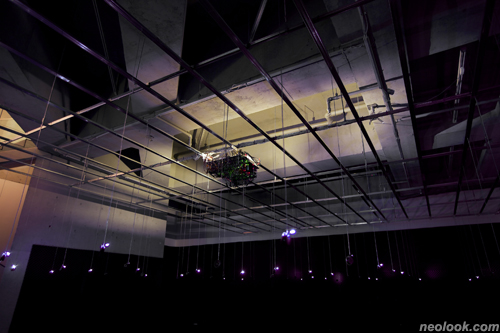- ● homepage
- ● archives
- ● restoration
- ● books
- ● big banners
- ● post board
- ■ neo's search
- ■ about us
- ■ 게재방법 안내
- 개인정보처리방침

- [email protected]
- Tel. 02_335_7922
- Fax. 02_335_7929
- 10:00am~04:30pm
- 월요일~금요일
- 3/3(월) 대체공휴일

Phantom Sign
김상진展 / KIMSANGJIN / 金尙塡 / mixed media 2014_0926 ▶ 2014_1026
● 위 이미지를 클릭하면 네오룩 아카이브 Vol.20131110d | 김상진展으로 갑니다.
초대 일시 / 2014_0926_금요일_06:00pm
후원 / 한국문화예술위원회
관람시간 / 11:00am~08:00pm
대안공간 루프 ALTERNATIVE SPACE LOOP 서울 마포구 와우산로29나길 20(서교동 335-11번지) Tel. +82.2.3141.1377 www.altspaceloop.com
대상에 대한 인식은 주체의 능력, 성향 등 그 개별성에 따라 지극히 편향적이고 상대적이다. 우리가 당연하다고 이해하거나 안다고 믿고 있는 것조차 우리의 유한한 능력으로 임의로 분류하고 부여한 규정과 질서의 극히 한정된 프레임 안에서 작동하므로 우리의 인식은 근본적으로 착오적 본성을 가진다. 그러한 프레임에서 벗어나 우리의 이해가 미치지 못하는 사실에 대해서는 더 쉽게 간과하고 만다. 더구나 특정 시대에, 특정한 방식으로 형성된 질서와 담론에 따라 인식체계가 가변적이라면 더욱 그러하다.

- 김상진_Dog Sounds_혼합재료_70x50x50 cm_2010
김상진 작가의 작업은 확고하다고 믿는 인식태도, 인식체계에 대한 의심에서 출발한다. 그의 작업 기저에 줄곧 묵직하게 자리하고 있는 것은 인간이 만든 질서, 규범, 거대 체계 등에서 나타나는 오류와 한계, 인간의 인식 체계/방식의 불안정성에서 비롯된 망실되고 은폐된 존재/사실의 확인으로 우리가 알고 있는 실재에 대한 불확실성, 인식과 실재 간의 괴리와 그로 인한 모순/부조리들을 들추어낸다. 우리의 인식은 태생적으로 불완전하므로 대상에 대한 완벽한 포착과 이해는 불가능하다. 어떠한 기호 체계(시각, 언어, 청각 기호 등)도 대상과 최대한 흡사하게는 가능할지 모르나 대상과 완벽하게 일대일로 대응할 수는 없다. 이러한 대상에 대한 인지 과정에서 오는 간극과 모순을 언어체계에서 찾고자 한 「Dog Sounds」(2010)는 이제 고전이 돼버린 소쉬르(Ferdinand De Saussure, 1857~1913)의 구조언어학 이론에서 말하는 '언어기호의 자의성'을 위트 있게 활용하고 있다. 누구나 한번쯤 경험했을 외국어의 의성어에서 오는 이질감과 거부감은 기표(signifiant)와 기의(signifié)의 결합에 있어 어떠한 필연성도 있을 수 없고 자의적 관계만이 성립함을 압축적으로 말해주는 사건일 것이다. ● '멍멍', 'bow wow' 등을 포함한 40개의 언어에서 48개의 개 짖는 의성어를 추출하여 동시에 재생시키는 이 작품은 마치 바벨탑 이전 언어의 재림을 기대하게 하듯 각 언어의 기표 간 결합을 시도하고 있다. 그러나 그 결과는 미궁 속으로 빠진다. 각 언어의 이질적인 기표들은 서로 충돌하고 기의와 완전히 단절되면서 의미 없이 둥둥 떠다니다 모호한 소리로 전락해 버린다. 다시 말해 실제 다수의 개짖는 소리인지 혹은 특정할 수 없는 소음에 가까운 소리인지 그 경계가 불분명해지면서 기표(의성어)로서의 기능을 상실하고 기의-기표 관계 설정 이전의 소리로 역변환된다. 소리(기표)와 관념은 완벽하게 필연적인 구조를 구축할 수 없기 때문에 그 사이에 엄연한 간극이 존재함은 우리를 둘러싸고 있는 실재에 대한 기호체계의 미비함을 확증할 뿐이다.

- 김상진_Sound Sculpture_Phantom Sign_혼합재료_가변크기_2014
디지털 테크놀로지 시대에 넘쳐나는 정보와 그것들로 촘촘히 짜여 있는 거대한 가상의 네트워크에 둘러싸인 우리는 그것의 무한한 가능성과 함께 그 이면에 밀착되어 있는 또 다른 차원의 인식론적 불확실성과 마주하고 있다. TV나 인터넷, 스마트폰 등 매체에 잠식된 현대인들은 보드리야르(Jean Baudrillard, 1929~2007)가 진단했듯 모든 것이 사건화되고 이슈화 되는 스펙터클이 난무하는 세상에 살고 있다. 이들에게는 스펙터클과 기호가 복제와 조작을 통해 강화되는 시뮬라시옹(simulation)과 그것이 생산하는 '과잉실재(hyper reality)'가 더 이상 낯설지 않다. 미디어 이론가 귄터 안더스(Gunther Anders, 1902~1992)는 『팬텀과 매트릭스로서의 세계』에서 보드리야르에 앞서 존재/부재, 사실/허구 어디에도 속하지 않는 제3의 존재층인 이러한 미디어(TV)의 속성을 두고 '팬텀(phantom)'이라 이른 바 있다. 이 팬텀으로 직조되는 시스템이 '매트릭스(matrix)'이다. 이 기만적인 가상현실 시스템에서 팬텀은 모상과 복제의 형태로 현실을 대체하는 것이다. 동시대 디지털 테크놀로지에 의한 복제기술의 첨단화는 모사본과 원본 사이의 간극을 더욱 철저하게 없애버린다. 우리는 원본 없는 사본의 자기 복제로 인해 진짜보다 더 진짜 같은 가짜가 지위를 보장받고 현실/가상, 실재/허구의 구분이 더 이상 의미 없는 '감각의 환영'에 중독되어 순응하며 살아가고 있는지 모른다.

- 김상진_Sound Sculpture_Phantom Sign_혼합재료_가변크기_2014
김상진은 이번 전시에서 처음으로 선보이는 「Sound Sculpture_Phantom Sign」(2014)에서 이러한 '감각의 환영'에 의한 실재의 인식론적 문제를 청각적 재현 메커니즘을 통해 다루고 있다. 1미터 격자 간격으로 84개의 녹음기와 스피커를 배치하고 각 위치에서 녹음된 사운드를 동일한 위치에서 다시 동시에 재생시킨다. 여기서 녹음된 상황극은 관객 참여형의 무대적 연출이 아닌 청취 메커니즘의 과정을 탐색하고 실험하기 위한 수행적 성격을 갖는다. 에디슨에 의해 처음으로 축음기가 발명된 지 130여 년이 지난 오늘날, 청각적 재현기술(음향기술)은 비약적으로 발전하여 3D 입체 영상 디스플레이의 대중화와 맞물려 돌비, 7.1채널, 9.1채널 등 다채널 서라운드 시스템과 같은 3D 입체 음향 시스템이 개발, 상용화되기에 이르렀다. 이 시스템은 진짜보다 더 진짜 같은 '실감 음향'을 재현하기 위해 음장(音場)을 인위적으로 만들고 가상의 음향을 복제하여 지정된 시스템 안에서 구현하기 때문에 청자를 여전히 '수동적이고 평면적으로' 배치시킨다. 이 때 음향은 개개인에게 최적화할 수도, 할 필요도 없는 표준화된 대량생산 체제의 필연적인 또 다른 공산품일 뿐이다. 이러한 시스템은 기술의 첨단화에도 불구하고 초창기 '소리의 원근법적 재현 방식'을 벗어나지 못하여 청자에게 일방적이고 획일적인 방식으로 청각적 시뮬라크르(simulacre)를 제공한다. 원근법의 또 다른 이름인 투시법은 르네상스 시기에 사물의 형태를 이상적으로 묘사하기 위해 발명된, '시점을 설정하는 방식'으로서 대상과 시선의 관계를 체계화시킨 지각양식이다. 대부분의 사람들이 지극히 과학적이고 고도의 재현력 향상에 필수적이라며 면죄부를 주는 이 메커니즘은 시각에서와 마찬가지로 청각 시스템에서도 특정한 방식으로 지각하도록 강요하며 그 안에서 청자의 행위, 판단, 사고까지 결정지으려 한다. 일찍이 아도르노(Theodor W. Adorno, 1903~1969)는 음반이 진정한 음악을 전달하지 못하고 청자의 지각방식을 특정한 패턴으로 고정시킴으로써 오히려 듣기 능력을 퇴보시킨다고 비판한 바 있다. 이렇듯 결정된 방식대로 지각하게 만드는 특별한 배치는 곧 권력이 작동하는 체제이다.

- 김상진_Sound Sculpture_Phantom Sign_혼합재료_가변크기_2014
기록과 재현의 다원화를 시도하고 있는 「Sound Sculpture_Phantom Sign」(2014)은 대칭과 균형, 안정을 중심으로 대상을 정확하고 이상적으로 영유할 수 있다는 이러한 투시법의 신화를 무너뜨린다. 청자는 기존 음향 시스템이 지배하는 당위적이고 규정적인 자리에서 벗어나 스피커 사이를 자유롭게 배회하며 원하는 위치에서 스스로 소리를 선택할 수 있다. 소리는 이제 더 이상 한 지점으로 수렴되지 않고 분열되어 다층적 레이어로 공간을 채운다. 복수의 청자들이 복수의 스피커가 제공하는 복수의 소리들을 각각 다른 지점에서 경험함으로써 기존 시스템이 지목한 유일하게 올바른 정보취득의 자리가 그 독점적, 특권적 지위를 잃게 된다. (모든 소리지점은 그 위치에서 녹음된 고유의 정보를 제공한다.) 그러나 한편으로 우리의 감각은 여전히 실감 음향 시스템에 의해 재단되어지는데 길들여지진 않았는지, 오히려 그런 시스템이 제공하는 진짜보다 더 진짜 같은 군더더기 없는 '환영적 음질'에 가려진 실제 소리를 외면하고 있진 않은지 자문해 보아야 할 것이다. 작가는 이 작품을 통해 "한 가지 사실이 생겨날 때 그 곳에는 다른 여러 가지 사실도 존재함을 보여주며, 정보자가 제공하는 소리 외에도 그 공간에 함께 존재했지만 기록되지 못했고 재현되지 못했던 다른 소리들에게 공평한 기회를 주고 싶었다"고 말한다. 그리고 "청자들이 얻고 싶은 소리를 가져다주기보다 재현된 소리들을 스스로 선택할 수 있게 하고자 한다"고 밝힌다. 마치 지젝(Slavoj Žižek, 1949~ )이 『실재의 사막에 오신 것을 환영합니다』를 통해 영화 「매트릭스」의 네오가 그랬듯 '실재를 깨닫게 해 주는 빨간 알약'을 삼키고 지금의 안온하지만 통제되는 매트릭스의 삶에서 한걸음 빠져 나와 우리가 현실에 대해 취해야 될 인식적 태도에 대해 성찰하라고 권하듯이 말이다. 작가는 가상의 현실을 걷어내고 어딘가에 함께 존재하지만 지젝의 표현을 빌자면 '대타자(법, 이데올로기, 더 나아가 전 지구적 자본주의)'에 의해 '무시되고 배제된' 진짜 현실을 등장시키면서 실재를 은폐하기 위해 잘 설계된 환영의 미로 안에서 헤매고 있는 우리에게 탈출할 수 있는 하나의 루트를 제시하고 싶었는지 모른다.

- 김상진_An Approximate Value_혼합재료_가변크기_2014
한편 작가는 「An Approximate Value」(2014)에서 인간의 욕망-자본주의, 인간중심주의 등-이 투영된, 즉 허구화해야 유지될 수 있는 기만적인 현실의 층위를 벗겨내고 실재의 적나라한 민낯을 보여주고자 한다. 기원 전후 전세계 인구는 2억 명에서 1800년대에는 10억 명, 2014년 현재 72억 명에 달하고 있다. 산업혁명 이후 급속한 상승세를 보인 세계인구는 불과 최근 100여 년 사이 3배 이상이라는 폭발적인 증가수치를 보이고 있는 반면, 지구 생물의 멸종 등 생태계 파괴 또한 빠른 속도로 진행되고 있다.(지금도 매시간 3종의 생물이 멸종하고 있다고 한다.) 스티븐 제이 굴드(Stephen Jay Gould, 1941~2002)가 『시간의 화살, 시간의 순환』에서 설명하듯이 45억년 지구의 역사를 24시간으로 환산해보면 마지막 1분 17초에 등장한다는 인류의 늑장 출현에 비하면 가히 역설적인 상황이 아닐 수 없다. 이러한 배경에는 의학 및 사회위생제도, 식량생산 기술과 같은 과학의 발전이라는 실증적 이유 외에도 인본주의적 가치관이 자리한다. '탈신화화'로 특징지어지는 서구 근대기의 휴머니즘은 자연을 장악, 통제하고 도구적으로 이용하는 오랜 습속을 낳았고 그 이후 현재까지도 인간이 자연에 대해 강력한 권위를 부여 받는 원리로 작용하고 있다. 그 덕분에 인간은 한없이 지고한 위치에서 그 외 모든 대상의 가치를 절하시킨다. 인류는 이러한 사유를 담보로 동식물뿐만 아니라 광물, 대기, 물을 비롯한 지구 생태계 전체를 자원(욕망)으로 대상화하는 것을 정당화한다. 심지어 생태계 보존조차 '유전자 운반체'로서의 자원 관리라는 인간중심적 가치를 위장하기 위한 명분으로 삼는다. 우리는 멸종위기 동물보호에서 생명의 존엄성이 인간의 욕망으로 왜곡됨을 종종 볼 수 있다. 지구상에 1,000마리 정도 남아 있는 것으로 추정되는 롤랜드 고릴라나 자이언트 판다, 고래 등과 같은 효용 가치(밀거래, 임대료, 관광자원 등)가 높은 동물이 '존엄한 생명'으로 극진한 대접을 받는 동안 무관심 속에 영원히 사라지고 있는 종은 얼마던가? 우리가 흔히 박애주의적 가면을 쓰고 얘기하는 멸종위기 동물(생태계) 보호는 '생명의 존엄성' 장막 뒤에서 인간의 욕망을 충족시켜 줄 (경제) 자원으로서의 가치, 희소성의 가치, 인간중심주의가 맞물려 작동하는 서늘한 위선적 미덕인 것이다.

- 김상진_An Approximate Value_혼합재료_가변크기_2014
김상진은 이 작품에서 우리가 희소성의 논리로 가치평가에 일반적으로 사용하는 기본 가치 산술법을 인간에게 적용시켜 수치화하고 있다. 지구상에 있는 인간 한 개체의 가치는 전체 인구 72억 분의 1이고 롤랜드 고릴라 한 마리의 가치(1000분의 1)는 인간 개체보다 720만 배나 높은 셈이다. 물론 다른 생물과 비교당할 수 없는, 생태계 최고 지위를 누리고 있는 '존엄한 인간'은 가치평가의 대상이 될 수 없기 때문에 이러한 비교는 경제학적으로나 상식적으로 넌센스이며 모욕적이기까지 하다. 작가는 이러한 극단적인 산술 적용을 통해 동시대 인간 생태계에서 인간의 욕망이 벌여놓은-대량생산과 무분별한 개발 등으로 인한- 자원고갈 및 식량위기 등의 자원 인플레이션과 그 관계항인 경제적 재화로서의 인간 개개인의 디플레이션을 비유적으로 드러내고 있다. 인간은 잉여 노동인구(구조조정에 의한 해고 및 실업문제), 소득분배의 불균형, 빈부격차 문제 등 인간가치 하락 현상들을 사회구조나 개인능력의 문제 등으로 치부함으로써 아이러니하게도 '인권'이나 '인간의 존엄성'과 같은 다른 종에 대해 무소불위의 위세를 떨쳤던 보호장치를 스스로 무위로 만들어 버리는 모순에 빠져있다. 아름답게 포장된 기만적 현실을 유지하기 위해 엄연히 존재하는 외상적(外傷的) 현실을 은폐하는 것은 누구를 위한 인도주의인 것인가? ■ 이정아
Cognition of a subject is extremely biased and subjective depending on the individuality of the subject, such as his or her ability or propensity. Even what we believe to understand and know works within a very limited frame of rules and order that are randomly categorized and assigned through our limited ability, thus our cognition fundamentally contains erroneous nature. However, outside this frame, for the facts that cannot be reached by our comprehension, we overlook them more easily. This is especially true if the cognitive system is variable depending on the order and discourse formed in particular era through particular method. ● Kim Sang Jin's work starts from having doubt about the cognitive attitude and system of firmly believing in something. Things that are constantly present in the basis of his work are error and limit appearing in man-made order, norms, and massive system, along with the lost and concealed presence/confirmation of fact brought by the instability of human's cognitive system/method, the contradictions/absurdities resulted from the gap among perception, cognition, and existence of the reality as we know it. Since our cognition is inherently imperfect, it is impossible to fully capture and understand the subject. Although it could be possible for some sign system (visual, lingual, auditory symbols, etc.) to resemble the subject as much as possible, it cannot correspond one-to-one perfectly with the subject. Dog Sounds (2010) aims to find the gaps and contradictions coming from the process of perceiving the subject and utilizes with the wit 'arbitrariness of linguistic symbol' spoken in what has become the classic, linguistic theory of Ferdinand De Saussure (1857~1913). The difference and repulsion coming from the onomatopoeia of foreign language would have experienced at least once cannot have any inevitability to combine signifiant and signifié, while only an arbitrary relationship will become the case that compressively tells the establishment. Simultaneously playing the extracted onomatopoeia sounds of 48 barking dogs from 40 languages including 'mung mung', 'bow wow', this work attempts to combine the signifiers of each language as if anticipating for the coming of the language before the Tower of Babel. However, the result becomes a mystery. The disparate signifiers of each language clash with each other, become completely disconnected with the signified, and finally degenerate into ambiguous sound after floating meaninglessly. In other words, since the boundaries of actual barking of numerous dogs or unspecified noise become unclear, it loses its function as a signifier (onomatopoeia) and is inverted to the sound before the previous relationship setting of signified-signifier. As the sound (signifier) and the concept cannot build an inevitable structure, the presence of undeniable gap between them confirms the lack of sign system in reality that surrounds us. ● In the digital technology era, surrounded by the overflowing information and a giant virtual network densely woven within it, we are faced with the epistemic uncertainty of another dimension that is adhered to the hidden side with its endless possibilities. Being eaten into by the media, such as TV, Internet, and smart phone, modern people live in the world where spectacles, in which everything becomes incidents and issues, are rampant as Jean Baudrillard (1929~2007) has diagnosed. For them, simulation, in which spectacle and sign are strengthened through replication and manipulation, and the hyper reality produced by it are not unfamiliar anymore. Prior to Baudrillard, a media theorist Gunther Anders (1902~1992) in The World as Phantom and as Matrix has called this properties of media (TV), phantom, which is a third dimension that does not belong to anywhere like presence/absence or fact/fiction. The system woven by this phantom is matrix. In this deceptive virtual reality, phantom replaces the reality in the form of imitation and replication. The advancement of cloning technology by contemporary digital technology more thoroughly gets rid of the gap between the copy and the original. On account of the self-replication of 'the replica without the original', perhaps we are addicted to and living by conforming to the 'phantom of feeling', in which the fake that is more realistic than the original is guaranteed a status and the division between reality/imagination, existence/fiction has no meaning any more. ● In Sound Sculpture_Phantom Sign (2014), presented for the first time in this exhibition, Kim Sang Jin deals with the epistemological problem of existence from this 'phantom of feeling' through the mechanism of auditory reproduction. The artist places 84 recorders and speakers at 1 meter grid spacing, and the sound recorded in each position is simultaneously played back at the same location. The recorded theatrical scene possesses a performative character to explore and experiment with the process of auditory mechanism but does not resemble staged direction that requires audience participation. Today, approximately 130 years since the invention of phonograph by Edison, the auditory reproduction technology(sound technology) has advanced rapidly, combined with the popularity of 3D stereoscopic displays, a 3D stereophonic sound system like multi-channel surround system, such as Dolby 7.1 channel and 9.1 channel and reached commercialization. In order to reproduce a more realistic 'Actual Feeling Sound', this system artificially creates sound field, reproduces virtual sound, and realizes it within the appointed system, thus it still places the audience 'passively and two-dimensionally'. At this moment, sound only becomes another inevitable industrial product within the standardized mass production system that cannot be and does not need to be optimized to each person. Despite the advancement of technology, this system cannot escape from the early 'perspective representation of sound', and it provides the audience with auditory simulacre in a unilateral and standardized way. Another name for perspective representation, perspective with vanishing point is invented for idealistically depicting the shape of the objects in the Renaissance. As a 'way to set the viewpoint', it is a perceptual mode that has systemized the relationship between the subject and the line of vision. Getting away with saying that it is a very scientific method, this system forces to perceive in a specific way within the auditory system as it is the case for the vision, and it makes to decide the listener's behavior, judgment, and thinking within it. On one occasion, Theodor W. Adorno (1903~1969) criticized that a record album degenerates the listening skills, since it does not communicate the real music and fixes the listener's manners of perception to specific patterns. Hence, special arrangement, which forces one to perceive in a determined manner, becomes a system that operates power. ● Seeking diversification of documentation and reproduction, Sound Sculpture_Phantom Sign (2014) destroys the myth of this perspective representation, claiming that it can clearly and idealistically possess the subject with symmetry, balance and stability in the center. The listener gets out of the normative and regulative position controlled by the existing sound system, wandering freely among the speakers, and is able to select the sound by himself. Sound no longer is taken into consideration as one point but is divided and fills the space with multi-layers. When multiple audiences listen to various sounds at different positions provided by numerous speakers, the only place for getting the correct information pointed by the existing system loses its exclusive, privileged position. (Every sound point provides its own information recorded in that location.) On the other hand, we would need to question ourselves whether our sense is still tamed for being cut out by Actual Feeling Sound Technology, or the system is abandoning the real sound hidden from the 'illusory sound' without superfluity, which is more realistic than the provided reality. Through this work, the artist says, "I want to show that there are other various existing facts when a new fact arises, and I wanted to give equal opportunity to the other sounds that could not be documented and reproduced while they existed in the same place as the sound provided by the informant." In addition, the artist reveals, "Instead of bringing to the audience the sound they want to obtain, I would like each one to choose the reproduced sounds on their own." Like Slavoj Žižek (1949~ ) proposed to take a step back from the present life in matrix which is peaceful but controlled and to contemplate our firm attitude towards the reality, which is implied in Welcome to the Desert of the Real, as Neo in the movie Matrix did by swallowing the red pill. Perhaps the artist wanted to skim off the imaginary reality and suggest a route to escape from the well-constructed illusory maze which has been concealing the existence by presenting the actual reality that exists somewhere with us but is 'ignored and excluded' by the Big Other (law, ideology, global capitalism by extension) borrowing the expression of Žižek. ● Meanwhile, in An Approximate Value (2014) the artist attempts to show the actual explicit naked face by peeling off the layer of the deceptive reality, in which human's ambition-capitalism and anthropocentrism are projected onto and which could be sustained only by fictionalization. Since year 0 AD till 1800s, the worldwide population grew from 200 million people to 1 billion people in 1800s, and it has now reached 7.2 billion people in 2014 today. Experiencing the rapid growth since the Industrial Revolution, the global population has shown explosive growth in numbers, more than three times, within just over recent 100 years; however, ecological damage like the extinction of the Earth Biology is also progressing at a fast pace. (It is said that 3 species are becoming extinct every hour at this moment.) As Stephen Jay Gould(1941~2002) explains in Time's Arrow, Time's Cycle, when converting the 4.5 billion years of the history of the Earth to 24 hours, humans appear in the last 1 minute 17 seconds, and compared to this late appearance, it is a paradoxical situation. In the background, there are humanistic values, in addition to the empirical reasons of the development of science like medical and social sanitation systems and the food production technology. Modern Western humanism, characterized as 'demythification', has produced a long-lived convention of dominating, controlling, and utilizing the nature, and since then it is still applied as the fundamentals for human to receive a powerful authority to the nature. Because of this, at an endlessly highest position, human being depreciates the value of any other subject. Secured by this reason, humans justify objectification of all ecosystem of the Earth as their resource (desire) including not only animals and plants, but also minerals, air and water. They even justify the preservation of ecosystem as 'gene carrier' for resource management, which is to disguise the anthropocentric value. We can often see the human dignity getting distorted by the human desire in the protection of endangered species. How many species are there disappearing forever in apathy while the animals with high effective value(trafficking, rental, tourism resources, etc.) like Roland gorillas estimated to remain around 1,000 of them on Earth, giant pandas and whales are treated with the utmost devotion as 'dignified life'? The protection of animals(ecosystem), in which we often talk about while wearing the philanthropic mask, is a frigid hypocritical virtue that would satisfy the desires of the human behind the stage by operating with the value of (economic) resource and scarcity and anthropocentrism. Kim Sang Jin in this work digitizes the arithmetic value of human with a method generally used in the value evaluation for the logic of scarcity. The value of one human entity on Earth is 1 over 7.2 million, the entire population. This means that the value of one Roland gorilla (1 over 1000) is 720 million times higher than one human entity. Since 'dignified human', enjoying the highest status of ecosystem, cannot be the subject of value evaluation, this comparison is both economically and commonsensically nonsense and even insulting. By applying this extreme calculation, the artist metaphorically reveals inflation of resources like resource depletion and food crisis-due to mass production and uncontrolled development-laid by the human desire and deflation of each human being as economic commodity, which is the referent of the former case. By regarding the depreciation of human value like surplus labor force (layoffs due to restructuring and unemployment), disparities in income distribution, wealth gap problem, and etc., as the problems of social structure and individual ability, ironically humans are lost in the contradiction that makes their protection like 'human rights' and 'human dignity' that has wielded absolute power over other species null and void on their own. Whose humanitarianism is it for if it conceals the traumatic reality distinctly existing to keep the beautifully covered hypocritical reality? ■ LEE Jung Ah
Vol.20140928e | 김상진展 / KIMSANGJIN / 金尙塡 / mixed media

